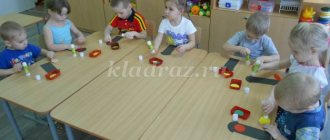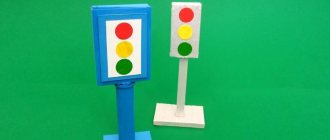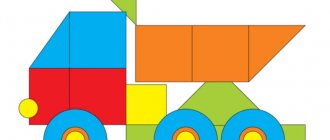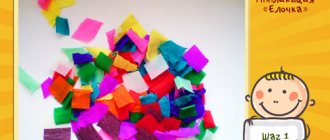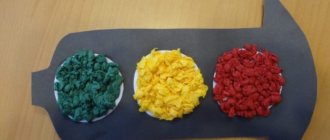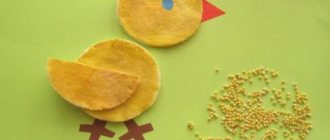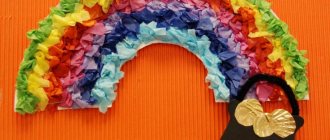Summary of an open lesson on application in the senior group “Be careful pedestrian, here is a road crossing”
Goal: to develop a consciously correct attitude towards compliance with traffic rules as a pedestrian.
Tasks:
1. Reinforce the rules of the road, teach how to apply knowledge previously acquired in practical activities.
2. Activate children’s thinking through:
— developing the ability to define tasks based on the problem posed,
- developing in children the ability to create a conceived product,
— improving the level of accumulated practical skills (creating a street layout, adding details to it).
3. Activate children’s speech through developing the ability to organize their actions.
4. Develop independence and the ability to interact with peers.
5. Strengthen the ability to correctly compose images from details.
6. Practice gluing parts carefully.
7. Cultivate in children an interest in the environment and applications.
8. Develop imagination and sense of composition.
Preliminary work with children: looking at illustrations of cars, guessing riddles “types of transport,” discussing problem situations “dangers on the road.”
With parents: invite parents to discuss and follow traffic rules for pedestrians while walking with their children.
Materials: magnetic board, pictures depicting transport, tinted landscape sheets F A4, blanks of colored paper with an outline of: cars, wheels, traffic lights, zebras; scissors, glue, napkins.
Types of children's activities in GCD:
Communicative.
Productive.
Gaming.
Motor.
Cognitive.
Integration of educational areas: “Cognition”, “Socialization”, “Communication”, “Artistic creativity”, “Physical education”.
Part 1 – Introductory
- Guys, today we have guests, let’s say hello to them and smile at them, and now let’s smile at each other.
“Come to me, look at the board,” please tell me what is shown in the pictures? (children's answers)
-I know that you love to play, and now I want to play a game with you. The game “Raise your hand, those who...” is played.
Raise your hand, those who like to play with cars?
Raise your hand, those who come to kindergarten on foot?
Raise your hand, those who come to kindergarten by bus?
Raise your hand, those who are brought to kindergarten by car?
Raise your hand, those whom your mother brought today?
Raise your hand, those whom dad brought today?
Raise your hand, those who come to kindergarten alone, without adults?
-Now you are all in a group, which means that you all come to kindergarten together with adults, with mom or dad, with grandparents. Why do you think? (children's answers). That's right, you and I know that the street is a place where you have to be very careful so that nothing bad happens.
Boxes
This is a wonderful material that makes interesting ones. You get a variety of traffic lights:
Option 1.
Cover a rectangular porridge and tea box with black paper or paint it with black paint. On one side stick 3 circles (red, yellow, green), cut out according to the template.
To make such a traffic light convenient to carry in the game, you need to cut off the top, make holes on the sides and insert a string into them.
Option 2.
We prepare the box as indicated above, and make the traffic light colors from origami by gluing the modules.
Option 3.
Take 3 match boxes and glue them together (you can use glue or self-adhesive paper). Wrap the resulting module in black paper and... Mark the traffic light cells with a white marker or strips of white paper, and paste a signal of the desired color into each.
Option 4.
A traffic light diagram consisting of 4 sidewalls and adding 1-2 cm for gluing (however, a ready-made narrow box with identical sides will do). Place the glued blank onto a leg made from a pencil. Place a roll of suitable size inside, painted with black paint. On the roll there are squares of signal colors located diagonally.
By turning such a roll inside a cardboard case, you can study how a traffic light regulates the movement of cars and pedestrians.
Important!
From boxes you can make traffic lights the size of a child - these will be useful for kindergarten. They are convenient to use during active games on knowledge of traffic rules.
Plasticine traffic light
When coming up with crafts on the theme “Fun traffic light”, do not forget about plasticine, which children love to play with and which can be found in almost every home. With basic modeling skills, you can make a textured or naturalistic traffic light.
Option 1.
The body of the road unit is molded from plasticine - it can be rectangular or oval. Lightly pressed circles of the desired colors are attached to one side. To make the structure more durable, you can insert a pencil or stick inside.
Option 2.
You can make a panel from plasticine. You will need cardboard inserted into a frame and plasticine.
A traffic light is drawn on cardboard, the entire plane is filled with plasticine of a neutral color (black, gray, beige). Signal lights are made from red, green and yellow plasticine. You can complicate the work if you use plasticine for the panel, formed into small balls - they are fixed to the base, slightly flattened.
Website of kindergarten teacher Anastasia Anatolyevna Voron
Tasks:
Educational:
- Learn to paste circles onto a rectangle, observing the order of pasting colors (red, yellow, green);
- to form ideas about the safety of pedestrians on the road; consolidate knowledge about primary colors (red, yellow, green).
Developmental:
- Develop the ability to lay out details and compose a whole image;
Educational:
- Develop skills in carefully working with glue; cultivate a desire to help others and evoke positive emotions from creative activity.
Preliminary work : reading fiction: S. Volkova “Road Rules”, watching cars, talking about traffic rules, listening to the song “Road Rules”.
Vocabulary work : color names “red, yellow, green”, “circle”, “one”, “two”, “three”, “rectangle”, “traffic light”,
"signal".
Demonstration material : magnetic board, finished sample of work, mock-up of a traffic light “without lights”, cut-out circles of red, yellow and green, steering wheel for games, magnets of three colors.
Handouts : cut circles of red, yellow and green colors, rectangular strips of paper for each child, jars for glue, napkins, stands for brushes, oilcloth.
Progress of the lesson.
The teacher pretends to be talking on the phone
Educator : Hold on, bunnies, we will definitely help you! (“When finishing a telephone conversation, the teacher hangs up the phone)
- Guys, the hares called me. They have a problem - the traffic light is broken.
Let's help them! What is a traffic light, who can tell?
(Children's answers)
Educator : Why is it needed, who can tell?
(Children's answers)
Educator : There needs to be a strict traffic light on the road so that there is order. He monitors the road so that people and cars do not violate traffic rules.
But the bunnies are in trouble - the traffic light is broken, and they cannot cross the road to return home.
So, look, this is a traffic light,” the teacher shows a ready-made example of a traffic light.
— It is rectangular, there are three buttons on it. What color are the buttons? (listing of colors) What shape are these buttons?
Children: Round
Educator : The first button is red, the second is yellow, the third is green. Let's count how many buttons?
The teacher and the children count the colors of the traffic lights.
Educator : To fix the traffic light, you need to glue three multi-colored circles onto a rectangle. They will signal to the bunnies when they need to cross the road. And for it to work, you need to glue the parts correctly, without confusing the buttons. Let's start with the red circle. Take the red circle and turn it white side up. Have you turned?
(The teacher takes a brush)
Educator : Take the tassels higher than your clothes. Dip the brush into the glue and dry the tail a little. We coat the entire white circle with glue, put the brush to rest on a stand, and glue the circle high, like I did. How many circles did you glue?
Children's response
Educator : How much did you wipe with a napkin?
(Children's response)
Educator : Which circle is next?
(Children's response)
Educator : Glue the yellow circle directly into the middle of the rectangle: turn it with the white side, coat it with glue. We place the brush to rest on the stand. Use another napkin to wipe the yellow circle.
The teacher shows how to wipe the circle with a napkin and, if necessary, helps the children do the work.
Educator : How many signals are ready?
(Children's answers)
Educator : Queue for the third circle. What color, who can tell?
(Children's response)
Educator : The third circle is green. We coat the white side with glue, carefully stick it to the very bottom of the rectangle, and put the brush to rest. Wipe the circle with a napkin.
The teacher turns over the traffic light and shakes it
Educator : Look, the traffic light has been fixed! All lights are in place! And you?
Children shake their works and “check” traffic lights.
Educator : Our traffic lights will dry out, and we will play “Flashing Lights”. The rules are as follows: there are only three signals, when the light is green, stomp your feet, when the light is yellow, wave your arms, when the light is red, freeze.
On a magnetic board on a model of a traffic light “without lights,” the teacher changes magnets and “switches” the signals. Children alternate movements.
Analysis of works
Educator : Thank you, guys, we helped the hares, and now it will be possible to install traffic lights at any intersection.
Lesson summary
Educator : So, at what signal will the hares cross the road?
(Children's response)
Educator : Guys, repeat:
“The color red is no road,
Yellow - wait a little,
And green - on the road again.
Paper miracles
If you approach the task creatively, you can create a lot from paper, and you don’t need designer or expensive paper - what’s in every home will come in handy.
Application
On the rectangular one we draw circles, keeping the same interval between them. Circles can be drawn with a compass or using a template, tracing the selected object (cup, saucer, jar). Then you can act on one of the options.
Option 1.
Take 3 sheets of colored paper - red, yellow and green - and tear them into small pieces. Each circle is filled with paper pieces.
Option 2.
You can cut out 3 colors of hearts of different sizes. Fold the hearts in half and glue them onto one half. It turns out beautifully if the hearts are laid out in a symmetrical order, forming a flower.
Option 3.
You can fill in the signal circles at a traffic light by cutting colored paper into small squares, then screw each square onto a pen rod and glue the end part onto the circle. You'll get a fluffy traffic light!
Important!
For such applications, you can use not only paper, but also everything you have at hand - eggshells, yarn, fur, felt. The main thing is that there are 3 colors - red, yellow, green. This craft will help your child forever remember that a traffic light is our best friend!
Origami
The traffic light is made using the kusudama method. You will need paper of 3 colors and a stand.
Cut into squares measuring 5x5 cm. The modules are assembled according to the diagram, then 3 modules are added together. 1 ball will require 24 blanks. A ball is assembled from the modules; it must be attached to a leg.
Crafts from scrap materials
You can make a traffic light from scrap materials.
From packages
You will need bags (cellophane or garbage bags), scissors, a plastic cover, tape, and thread.
Progress:
- The bags are placed in a stack, the bottom and handles are cut off to get even rectangles.
- Rings are cut out of 2 plastic lids or cardboard.
- 2 rings are folded together and wrapped with cellophane strips.
- Cut the cellophane along the outer contour.
- Spread the rings and tie the pompom with thread.
- Align the length of the pompom pile.
- Connect 3 pom-poms of different colors together on a thread.
This traffic light can be hung or attached to the wall. Using this principle, you can make a traffic control mechanism from threads and wrapping paper.
Sewn traffic light
An interesting option is a traffic light made from fabric. It can serve as an educational toy if the colors are made removable by attaching them with Velcro.
The outline of a traffic light is cut out of black fabric and sewn together with padding polyester or interlining. It is more convenient to make signal colors from felt.
Sweet "red-yellow-green"
After eating a delicious traffic light, every child will remember the rules for crossing the street. It’s not difficult to prepare such delicacies: you can bake cookies or take ready-made ones.
The main secret is in the decoration.
Cookies, waffles or sweet buns should be poured on top with chocolate and, before it hardens, place three candies of the desired colors (red, yellow, green) on top. These could be caramels, candied fruits or M&Ms. That's all!
From a plastic bottle
It would seem that an empty plastic bottle is a waste item, but how much can be made from it! can be done in different ways.
Option 1.
3 caps are painted in signal colors and are attached to an empty bottle. A stick attached to another lid-stand is inserted into the bottle cap. That's all!
Option 2.
A bottle craft can become a real masterpiece. To do this, paint the bottle a neutral color, turn the lid down and draw or stick on eyes, nose, and mouth using self-adhesive tape. Place the signals in the middle. Glue hands from cardboard or fabric to the sides, and make legs from below. You can give the traffic light a police baton and a traffic sign.
